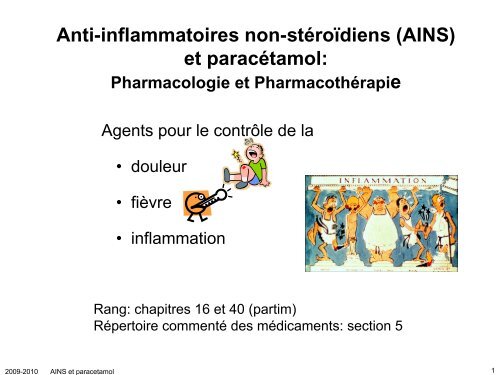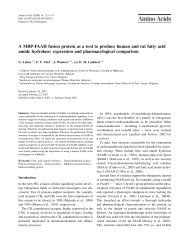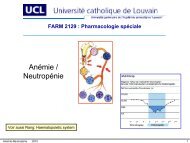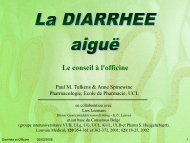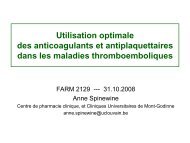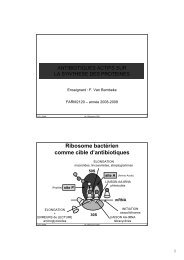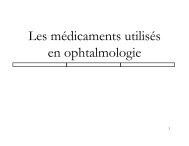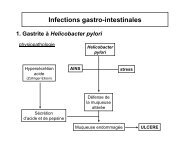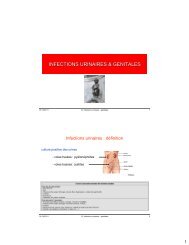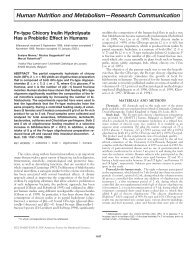Anti-inflammatoires non-stéroïdiens (AINS) et paracétamol:
Anti-inflammatoires non-stéroïdiens (AINS) et paracétamol:
Anti-inflammatoires non-stéroïdiens (AINS) et paracétamol:
Create successful ePaper yourself
Turn your PDF publications into a flip-book with our unique Google optimized e-Paper software.
<strong>Anti</strong>-<strong>inflammatoires</strong> <strong>non</strong>-<strong>stéroïdiens</strong> (<strong>AINS</strong>)<br />
<strong>et</strong> <strong>paracétamol</strong>:<br />
Pharmacologie <strong>et</strong> Pharmacothérapie<br />
Agents pour le contrôle de la<br />
•<br />
•<br />
•<br />
douleur<br />
fièvre<br />
inflammation<br />
Rang: chapitres 16 <strong>et</strong> 40 (partim)<br />
Répertoire commenté des médicaments: section 5<br />
2009-2010 <strong>AINS</strong> <strong>et</strong> parac<strong>et</strong>amol 1
•<br />
•<br />
•<br />
Thermorégulation ...<br />
L'hypothalamus antérieur possède un centre<br />
réglé sur 37°C<br />
il reçoit des informations en provenance de la<br />
périphérie sur<br />
–<br />
–<br />
l'environnement<br />
le niveau d'activité<br />
physique<br />
il agit via des effecteurs périphériques<br />
–<br />
–<br />
–<br />
métabolisme<br />
activité physique<br />
comportement (mise à<br />
endothermes<br />
l'abri, <strong>et</strong>c.....) ectothermes<br />
2009-2010 <strong>AINS</strong> <strong>et</strong> parac<strong>et</strong>amol 2
•<br />
•<br />
•<br />
•<br />
•<br />
•<br />
•<br />
•<br />
•<br />
Physiopathologie de la fièvre...<br />
Infections<br />
toxines<br />
pyrogènes exogènes<br />
Monocytes<br />
macrophages<br />
cellules endothéliales<br />
lymphocytes<br />
Pyrogènes endogènes<br />
cytokines:<br />
IL-1, TNF, IL-6, IFN<br />
Fièvre<br />
Elévation du point<br />
de contrôle<br />
Prostaglandine E2<br />
Centre thermorégulateur<br />
hypothalamique<br />
2009-2010 <strong>AINS</strong> <strong>et</strong> parac<strong>et</strong>amol 3
•<br />
•<br />
•<br />
•<br />
Points importants pour la fièvre ...<br />
distinguer fièvre <strong>et</strong> hyperthermie (coup de chaleur,<br />
intoxication aux salicylates, fièvre atropinique, halothane...)<br />
connaître la notion de pyrogènes<br />
–<br />
–<br />
exogènes (produits bactériens, ...)<br />
endogènes (princip. l'interleukine 1)<br />
comprendre l'utilité<br />
de la fièvre<br />
connaître les risques de la fièvre <strong>non</strong>-contrôlée<br />
(augmentation importante du métabolisme, disconfort, convulsions<br />
[surtout chez l'enfant]).<br />
2009-2010 <strong>AINS</strong> <strong>et</strong> parac<strong>et</strong>amol 4
•<br />
•<br />
•<br />
Douleur ...<br />
propagation d'un influx nerveux à<br />
la périphérie ...<br />
contrôlé<br />
–<br />
–<br />
par<br />
par des facteurs humoraux<br />
par le système nerveux périphérique...<br />
partir de<br />
transmission vers le système nerveux<br />
central (cortex) sous le contrôle de voies<br />
descendantes ...<br />
opiacés...<br />
<strong>AINS</strong><br />
2009-2010 <strong>AINS</strong> <strong>et</strong> parac<strong>et</strong>amol 5
•<br />
•<br />
•<br />
Types de sensations douloureuses<br />
Douleurs nociceptives<br />
–<br />
–<br />
Les nocicepteurs sont les terminaisons libres des fibres<br />
nerveuses conduisant l'influx nerveux induit par des stimulations<br />
intenses d'origine mécanique, thermique ou chimique. Ces<br />
terminaisons libres sont localisées dans la peau, les muscles,<br />
les articulations <strong>et</strong> les viscères.<br />
Résultant d'une lésion tissulaire, les douleurs nociceptives sont<br />
très souvent associées à des processus <strong>inflammatoires</strong> qui<br />
entr<strong>et</strong>iennent ou amplifient l'activation des nocicepteurs.<br />
Ces douleurs réagissent bien aux antalgiques conventionnels<br />
Douleurs neuropathiques<br />
Douleurs psychogènes<br />
2009-2010 <strong>AINS</strong> <strong>et</strong> parac<strong>et</strong>amol 6
•<br />
•<br />
•<br />
Types de sensations douloureuses<br />
Douleurs nociceptives<br />
Douleurs neuropathiques<br />
–<br />
–<br />
–<br />
Les douleurs neuropathiques sont liées à une ou des lésions du<br />
système nerveux.<br />
liées à un dysfonctionnement du système nerveux, aux<br />
mécanismes complexes, tant périphériques que centraux.<br />
La douleur neuropathique est une douleur spontanée s’exprimant<br />
en dehors de toute stimulation périphérique, <strong>et</strong> ce, à l’opposé des<br />
douleurs par excès de nociception.<br />
Ces douleurs sont habituellement peu sensibles aux antalgiques<br />
<strong>et</strong> fréquemment à l’origine de plaintes chroniques car la lésion<br />
neurologique est souvent définitive.<br />
Douleurs psychogènes<br />
2009-2010 <strong>AINS</strong> <strong>et</strong> parac<strong>et</strong>amol 7
•<br />
•<br />
•<br />
Types de sensations douloureuses<br />
Douleurs nociceptives<br />
Douleurs neuropathiques<br />
Douleurs psychogènes<br />
–<br />
–<br />
<br />
<br />
En rapport avec une problématique psychologique (suite de deuil…) ou<br />
psychopathologique (angoisse…) caractérisée qui s’exprime au travers du corps <strong>et</strong><br />
dont le diagnostic repose avant tout sur les signes suivants : éléments du discours,<br />
personnalités pathologiques entrant dans le cadre d’une névrose hystérique, d’une<br />
hypocondrie…<br />
En aucun cas, il ne s’agit d’un diagnostic lié à l’absence de cause organique<br />
décelable.<br />
Douleur “refuge” (décrite comme invalidante) mais en fait mode de résolution<br />
inconscient de certains conflits, organisant la vie du patient <strong>et</strong> de son entourage<br />
autour du symptôme.<br />
Il est parfois préférable de laisser les choses en l’état plutôt que de rompre un<br />
équilibre organisé.<br />
si une intervention est considérée comme souhaitable, elle doit être faite par un<br />
professionnel des approches cognitives (psychologue, psychiatre)<br />
2009-2010 <strong>AINS</strong> <strong>et</strong> parac<strong>et</strong>amol 8
Mécanismes de transduction des voies nociceptives<br />
Rang (figure 40.6)<br />
2009-2010 <strong>AINS</strong> <strong>et</strong> parac<strong>et</strong>amol 9
Contrôle du passage<br />
l'information<br />
douloureuse vers le<br />
système nerveux<br />
central:<br />
système à guich<strong>et</strong>s<br />
(périphérie)<br />
Rang (figure 40.4)<br />
2009-2010 <strong>AINS</strong> <strong>et</strong> parac<strong>et</strong>amol 10
Contrôle du passage<br />
l'information<br />
douloureuse vers le<br />
système nerveux<br />
central:<br />
rôles des voies<br />
descendantes<br />
(système nerveux central<br />
Rang (figure 40.5)<br />
2009-2010 <strong>AINS</strong> <strong>et</strong> parac<strong>et</strong>amol 11
•<br />
•<br />
Inflammation<br />
Séquence <strong>et</strong> symptomes cellulaires<br />
–<br />
–<br />
–<br />
–<br />
vasodilatation - adhésion plaqu<strong>et</strong>taire <strong>et</strong> leucocytaire - exsudation<br />
par de la perméabilité vasculaire<br />
recrutement (polymorphonucléaires, macrophages, lymphocytes)<br />
<strong>et</strong> prolifération cellulaire (fibroblastes)<br />
libération de cytokines *, de prostaglandines, <strong>et</strong> d'enzymes<br />
protéolytiques<br />
tentative de régénération - fibrose<br />
Symptômes généraux (3 premiers stades)<br />
–<br />
"rubor - calor - tumor - dolor"<br />
* IL-1: réponse immune, inflammation locale...<br />
* TNF: destruction tissulaire (eff<strong>et</strong>s systémiques)<br />
* IL-2: lymphocytes T, B <strong>et</strong> cellules NK ("natural killers")<br />
2009-2010 <strong>AINS</strong> <strong>et</strong> parac<strong>et</strong>amol 12
•<br />
•<br />
Causes de l'inflammation<br />
Facteurs déclenchant la phase vasculaire <strong>et</strong><br />
plasmatique<br />
–<br />
–<br />
–<br />
traumatismes<br />
libération de facteurs bactériens<br />
réactions immunes (Ag-Ac)<br />
Facteurs responsables du maintien de la phase<br />
exsudative <strong>et</strong> de recrutement<br />
–<br />
–<br />
libération exagérée de cytokines<br />
libération <strong>non</strong> contrôlée d'enzymes protéolytiques<br />
L'inflammation est une réaction normale de défense, mais qui peut devenir<br />
exagérée <strong>et</strong> se maintenir de façon trop prolongée …<br />
2009-2010 <strong>AINS</strong> <strong>et</strong> parac<strong>et</strong>amol 13
Relations cytokines –<br />
TNF-α<br />
IL-1<br />
•<br />
•<br />
•<br />
<br />
<br />
<br />
Perméabilité<br />
inflammation <strong>et</strong> prostaglandines<br />
vasculaire<br />
Exsudation / diapédèse<br />
Libération de médiateurs par activation de la<br />
cascade du complément<br />
Activation du facteur de transcription NF-B<br />
synthèse de médiateurs de l'immunité <strong>et</strong> de<br />
l'inflammation<br />
Activation de la cyclo-oxygénase<br />
synthèse des prostaglandines<br />
2009-2010 <strong>AINS</strong> <strong>et</strong> parac<strong>et</strong>amol 14
COX Activity<br />
1600<br />
1200<br />
800<br />
400<br />
0<br />
Effect of IL-1 and dexam<strong>et</strong>hasone<br />
on human fibroblast COX activity<br />
Raz <strong>et</strong> al, PNAS, 86,1657-1661<br />
Control IL-1 IL IL-1 IL 1 + Dex<br />
2009-2010 <strong>AINS</strong> <strong>et</strong> parac<strong>et</strong>amol 15
Stimulus<br />
inflammatoire<br />
phospholipase A 2<br />
prostaglandines<br />
PGE2 PGD2 •<br />
•<br />
vasodilatation<br />
de l'agrégation<br />
plaqu<strong>et</strong><strong>et</strong>taire<br />
Métabolisme<br />
des eicosanoïdes<br />
phospholipides<br />
acide<br />
endoperoxides<br />
arachidonique<br />
thromboxanes<br />
•<br />
•<br />
vasoconstriction<br />
de l'agrégation<br />
plaqu<strong>et</strong>taire<br />
cycliques<br />
(vue<br />
générale)<br />
leucotriènes<br />
leucotri nes<br />
prostacyclines<br />
PGI2 2009-2010 <strong>AINS</strong> <strong>et</strong> parac<strong>et</strong>amol 16<br />
•<br />
•<br />
•<br />
•<br />
bronchoconstriction<br />
vasodilatation<br />
de l'agrégation<br />
plaqu<strong>et</strong><strong>et</strong>taire<br />
potentialisation de<br />
la douleur
O<br />
O<br />
O<br />
O<br />
Métabolisme<br />
OOH<br />
OH<br />
de l'acide<br />
COOH Arachidonic Acid<br />
COOH<br />
COOH<br />
2 O 2<br />
2 e -<br />
PGG 2<br />
PGH 2<br />
arachidonique<br />
Cyclooxygenase<br />
Hydroperoxidase<br />
prostanoids<br />
• prostaglandins<br />
• thromboxans<br />
2009-2010 <strong>AINS</strong> <strong>et</strong> parac<strong>et</strong>amol 17
Mapping of the cyclooxygenase<br />
active site<br />
2009-2010 <strong>AINS</strong> <strong>et</strong> parac<strong>et</strong>amol 18
•<br />
•<br />
•<br />
•<br />
Découverte des anti-douleurs à action antipyrétique <strong>et</strong><br />
anti-inflammatoire<br />
Quinquina (très ancien) -<br />
... actif contre les fièvres <strong>et</strong> le paludisme<br />
... quinine (arbre des jésuites)<br />
Écorce de saule ... (très ancien)<br />
... mêmes propriétés pour la fièvre (mais pas le paludisme) plus antidouleur <strong>et</strong><br />
anti-inflammatoire ...<br />
– contient du salicoside (dérivé glycosidique)<br />
– découverte de l'acide salicylique (Kolbe, 1860)<br />
– synthèse de l'acide acétylsalicylique (1899)<br />
... action antidouleur, antipyrétique, anti-inflammatoire, antiaggrégante …<br />
Dérivés de l'aniline (1930 ...)<br />
... phénacétine - <strong>paracétamol</strong> (ac<strong>et</strong>aminophen)<br />
... antidouleur uniquement ...<br />
Premiers dérivés de type anthraniliques (<strong>AINS</strong>)<br />
... action antidouleur, antipyrétique, anti-inflammatoire, antiagrégante<br />
2009-2010 <strong>AINS</strong> <strong>et</strong> parac<strong>et</strong>amol 19<br />
..
F<br />
H 3C<br />
De l'acide salicylique <strong>et</strong> ses dérivés vers les <strong>AINS</strong><br />
F<br />
H<br />
N<br />
COOH<br />
OH<br />
COOH<br />
OH<br />
COOH<br />
OH<br />
acide salicylique<br />
diflunisal<br />
H 3C acide méfénamique<br />
CH 3<br />
H 3C CH 3<br />
COOH<br />
ibuprofène<br />
renforcement croissant de l'activité !!<br />
2009-2010 <strong>AINS</strong> <strong>et</strong> parac<strong>et</strong>amol 20
Filling up the enzyme with salicylic acid ...<br />
heme<br />
Hydrophobic<br />
channel<br />
OH OH<br />
tyrosine at 385<br />
C<br />
O<br />
2009-2010 <strong>AINS</strong> <strong>et</strong> parac<strong>et</strong>amol 21<br />
+<br />
- O<br />
Arginine at 120
Filling up the enzyme with flurbiprofen...<br />
heme<br />
Hydrophobic<br />
channel<br />
F<br />
tyrosine at 385<br />
CH3<br />
Arginine at 120<br />
2009-2010 <strong>AINS</strong> <strong>et</strong> parac<strong>et</strong>amol 22<br />
COOH<br />
+<br />
F<br />
CH 3<br />
COOH
Mapping of the cyclooxygenase<br />
COX-1 Active Site<br />
occupied by<br />
flurbiprofen<br />
Picot, Loll and Garavito: Nature 1994; 367:243.<br />
active site<br />
tyrosine 385<br />
arginine 120<br />
2009-2010 <strong>AINS</strong> <strong>et</strong> parac<strong>et</strong>amol 23
Tous les <strong>AINS</strong> conventionels sont des "analogues" <strong>non</strong>-oxydables de l'acide<br />
arachidonique possédans une fonction acide ionisable à pH physiologique …<br />
acide arachidonique<br />
acide salicylique<br />
CH 3<br />
H 3C CH 3<br />
COOH<br />
COOH<br />
OH<br />
COOH<br />
ibuprofène<br />
2009-2010 <strong>AINS</strong> <strong>et</strong> parac<strong>et</strong>amol 24<br />
H 3C<br />
O<br />
Cl<br />
O<br />
O<br />
S<br />
N<br />
H 3C C<br />
HN<br />
N<br />
N<br />
COOH<br />
O<br />
O<br />
OH<br />
CH 3<br />
indométhacine<br />
pK=6.3<br />
piroxicam
•<br />
•<br />
•<br />
•<br />
•<br />
•<br />
Classes d'<strong>AINS</strong> conventionnels * disponibles en Belgique<br />
arylacétates:<br />
arylpropionates:<br />
indoliques:<br />
oxicams:<br />
nimésulide<br />
(voir dia 40)<br />
phénylbutazone<br />
* c.à.d. <strong>non</strong> cox-2 sélectifs<br />
diclofenac, sulindac, …<br />
ibuprofène, naproxène, …<br />
(voir dia 24)<br />
indométhacine…<br />
(voir dia 24)<br />
piroxicam, ténoxicam…<br />
(voir dia 24)<br />
2009-2010 <strong>AINS</strong> <strong>et</strong> parac<strong>et</strong>amol 25<br />
O<br />
N<br />
H 3C<br />
N<br />
H 3C<br />
OH<br />
O<br />
O<br />
O<br />
Cl<br />
Cl<br />
S<br />
HN<br />
N<br />
H 3C C<br />
HN<br />
N<br />
S<br />
COOH<br />
CH 3<br />
O<br />
COOH<br />
OH
Les <strong>AINS</strong> ont tous un même mode d'action mais diffèrent<br />
(essentiellement) par leur demi-vie…<br />
•<br />
•<br />
•<br />
•<br />
ac. acétylsalicylique<br />
arylpropionates<br />
(ibuprofène, naproxène...)<br />
Arylacétates / indoliques<br />
(diclofénac / indométhacine...)<br />
oxicames<br />
(piroxicam)<br />
tmax demi-vie liaison aux<br />
(h) 1 (h) 2 protéines (%)<br />
0.25-0.4 2-4* 70-80<br />
2009-2010 <strong>AINS</strong> <strong>et</strong> parac<strong>et</strong>amol 26<br />
1-2<br />
1-2<br />
3-5<br />
2-4<br />
1-11<br />
45<br />
60-99<br />
90-99<br />
1 détermine le temps nécessaire pour obtenir l'eff<strong>et</strong> anti-douleur maximal<br />
2 détermine la durée d'action globale<br />
* inhibiteur irréversible: l'action sera plus prolongée que ne le laisse supposer la demivie…<br />
99
Upper - GI<br />
Renal<br />
Adverse Effects of common NSAIDs<br />
Erosions - bleedings<br />
Ulcers / perforations<br />
Anemia<br />
Dyspepsia<br />
Renal dysfunction<br />
Renal failure<br />
Blood pressure<br />
Heart failure<br />
<strong>Anti</strong>-platel<strong>et</strong> effects<br />
blood loss<br />
Lung effects<br />
bronchospasm<br />
Skin effects<br />
rash<br />
urticaria<br />
photosensitivity<br />
Other effects<br />
bone marrow<br />
depression<br />
liver failure<br />
varia<br />
2009-2010 <strong>AINS</strong> <strong>et</strong> parac<strong>et</strong>amol 27
X<br />
Support Renal and<br />
Platel<strong>et</strong> Function<br />
Role of cyclooxygenase<br />
Arachidonic Acid<br />
Cyclooxygenase<br />
X<br />
Prostaglandins<br />
X<br />
Protect<br />
Gastric Mucosa<br />
Shorrock CJ <strong>et</strong> al. Am J Med 1988;84 (Suppl):25-34.<br />
Inflammation and<br />
Pain<br />
2009-2010 <strong>AINS</strong> <strong>et</strong> parac<strong>et</strong>amol 28<br />
{<br />
X<br />
…<br />
leucotriènes<br />
leucotri nes
X<br />
Support Renal and<br />
Platel<strong>et</strong> Function<br />
Role of cyclooxygenase<br />
Arachidonic Acid<br />
Cyclooxygenase<br />
X<br />
Prostaglandins<br />
X<br />
Protect<br />
Gastric Mucosa<br />
Shorrock CJ <strong>et</strong> al. Am J Med 1988;84 (Suppl):25-34.<br />
X<br />
Inflammation and<br />
Pain<br />
2009-2010 <strong>AINS</strong> <strong>et</strong> parac<strong>et</strong>amol 29<br />
…<br />
leucotriènes<br />
leucotri nes<br />
bronchospasme
%<br />
30<br />
25<br />
20<br />
15<br />
10<br />
5<br />
0<br />
GI<br />
intolerability*<br />
30<br />
NSAIDs<br />
endoscopic<br />
ulcers [3]<br />
10<br />
* Range 20-50% based on<br />
- withdrawals for GI symptoms1 - community surveys for GI symptoms2 toxicity<br />
GI Mucosal Damage /<br />
Complications<br />
perforation or<br />
haemorrhage [4]<br />
Death [5]<br />
1. Kiff <strong>et</strong> al, Eur J Rheumatol, 1994; 2. Hardo <strong>et</strong> al, BJCP, 1993; 3. Graham DY <strong>et</strong> al, Am J Gastroenterol 1988;<br />
4. Silverstein <strong>et</strong> al, Ann Int Med, 1995; 5. Blower <strong>et</strong> al, Aliment Pharmacol, 1997<br />
2009-2010 <strong>AINS</strong> <strong>et</strong> parac<strong>et</strong>amol 30<br />
1.7<br />
0.2
•<br />
•<br />
•<br />
•<br />
•<br />
NSAID Ulcers and Ulcer Complications<br />
Endoscopic ulcer point prevalence: 10-30%<br />
Ulcer complications: 2-4% per year<br />
Most (>80%) hospitalizations for GI bleed occur<br />
without previous symptoms<br />
Inhibition of prostaglandin synthesis is principal<br />
mechanism for GI damage<br />
Use of antacids or H2 antagonists do not prevent<br />
NSAID induced gastric ulcers<br />
Singh G <strong>et</strong> al. Am J Med 1998;105(1B):31S-8S.<br />
Geis GS <strong>et</strong> al. J Rheumatol 1991;18:11-14.<br />
2009-2010 <strong>AINS</strong> <strong>et</strong> parac<strong>et</strong>amol 31
GI mortality associated with typical<br />
NSAIDs vs other causes in US<br />
Cigar<strong>et</strong>te smoking<br />
Cancer<br />
NSAID use<br />
Motor vehicle accident<br />
Home accident<br />
Airplane crash (frequent flyer)<br />
Annual risk of death (%)<br />
0.0 0.1 0.2 0.3 0.4<br />
Fries <strong>et</strong> al. Am J Med. 1991;91:213–222;<br />
Wilson, Crouch. Science. 1987;236:267–270.<br />
2009-2010 <strong>AINS</strong> <strong>et</strong> parac<strong>et</strong>amol 32
*NSAIDs<br />
-<br />
Relative Risk of GI Complications<br />
Drug Relative Risk (95% C.I.)<br />
None 1<br />
Ibuprofen 2.1 (0.6 - 7.1)<br />
Diclofenac 2.7 (1.5 - 4.8)<br />
Other NSAID (n=16) 2.9 (1.4 - 6.3)<br />
K<strong>et</strong>oprofen 3.2 (0.9 - 11.9)<br />
Naproxen 4.3 (1.6 - 11.2)<br />
Tenoxicam 4.3 (1.9 - 9.7)<br />
Nimesulide 4.4 (2.5 - 7.7)<br />
Indom<strong>et</strong>hacin 5.5 (1.6 - 18.9)<br />
Piroxicam 9.5 (6.5 - 13.8)<br />
K<strong>et</strong>orolac 24.7 (9.6 - 63.5)<br />
* Rodriguez <strong>et</strong> al, Arch Intern Med, 1998, 158, 33-39<br />
2009-2010 <strong>AINS</strong> <strong>et</strong> parac<strong>et</strong>amol 33
•<br />
•<br />
•<br />
Discovery of two forms of cyclooxygenase<br />
1989 ... IL-1 induces COX activity in fibroblasts 1<br />
1990 … the inducible COX activity is inhibited by<br />
steroids 2<br />
BUT steroids have no effect on basal<br />
cyclooxygenase activity<br />
1991 … the inducible cycloxygenase (COX-2)is cloned 3<br />
–<br />
–<br />
–<br />
60% identical to COX-1<br />
certain important amino acid differences<br />
cytokine-induced and regulated by glucocorticoids<br />
1 : Raz <strong>et</strong> al, PNAS, 1989, 86, 1657-1661<br />
2 : Fu <strong>et</strong> al, J Biol Chem, 1990, 265. 16737-40<br />
3 : Xie <strong>et</strong> al, 1991, PNAS, 88, 2692-6<br />
2009-2010 <strong>AINS</strong> <strong>et</strong> parac<strong>et</strong>amol 34
COX-2: a new anti-inflammatory drug targ<strong>et</strong><br />
COX-1<br />
(constitutive)<br />
Stomach<br />
Intestine<br />
Kidney<br />
Platel<strong>et</strong><br />
Arachidonic Acid<br />
(–)<br />
conventional<br />
NSAIDs<br />
COX-2<br />
(inducible)<br />
Inflammatory Site<br />
• Macrophages<br />
• Synoviocytes<br />
• Endothelial cells<br />
2009-2010 <strong>AINS</strong> <strong>et</strong> parac<strong>et</strong>amol 35<br />
(–)<br />
•<br />
•<br />
•<br />
Glucocorticoids<br />
(block mRNA<br />
expression)<br />
Brain<br />
Kidney<br />
Female U/G tract
•<br />
•<br />
•<br />
•<br />
Biochemical comparisons of the Cox-1 and Cox-2<br />
COX-1 and COX-2 are membrane-bound proteins … in the endoplasmic<br />
r<strong>et</strong>iculum.<br />
COX-1 and COX-2 share 60% homology at the amino acid level; both<br />
catalyze from arachidonic acid the formation of prostaglandin (PG) G2 followed by PGH2 via a peroxidase function<br />
COX-1 and COX-2 have important differences in the catalytic regions,<br />
particularly the exchange of Ile in COX-1 for Val in COX-2 at position 523.<br />
This substitutions results in a larger and more flexible substrate channel in<br />
COX-2 than in COX-1 and in the inhibitor binding site in COX-2, being 25%<br />
larger than that in COX-1.<br />
Warner TD, Mitchell JA. Cyclooxygenases: new forms, new inhibitors, and lessons from<br />
the clinic. FASEB J. 2004 May;18(7):790-804.<br />
2009-2010 <strong>AINS</strong> <strong>et</strong> parac<strong>et</strong>amol 36
heme<br />
Kurumbail RG <strong>et</strong> al. Nature 1996;384:644-8.<br />
Structures of COX-1 and COX-2<br />
COX-1<br />
hydrophobic<br />
channel<br />
tyrosine at 385<br />
+<br />
arginine at 120<br />
COX-2<br />
hydrophobic<br />
channel<br />
hydrophilic<br />
“side pock<strong>et</strong>”<br />
tyrosine at 385<br />
arginine at 120<br />
2009-2010 <strong>AINS</strong> <strong>et</strong> parac<strong>et</strong>amol 37<br />
+
Conventional NSAIDs<br />
heme<br />
COX-1<br />
tyrosine at 385<br />
Kurumbail RG <strong>et</strong> al. Nature 1996;384:644-8.<br />
+<br />
arginine at 120<br />
inhibit both COX-1 and COX-2<br />
COX-2<br />
tyrosine at 385<br />
arginine at 120<br />
binding to Arg 120<br />
through carboxyalate is enough...<br />
2009-2010 <strong>AINS</strong> <strong>et</strong> parac<strong>et</strong>amol 38<br />
+
H3 CO<br />
hydrophilic<br />
group<br />
Pharmacochemistry<br />
Nabum<strong>et</strong>one<br />
H 3 C<br />
O<br />
S<br />
O<br />
NH<br />
NO 2<br />
O<br />
CH 2 CH C 2<br />
O<br />
CH 3<br />
Nimesulide<br />
of the COX-2 inhibitors<br />
2009-2010 <strong>AINS</strong> <strong>et</strong> parac<strong>et</strong>amol 39<br />
H 2<br />
H 3 C<br />
N<br />
O<br />
O<br />
S<br />
CH 3<br />
S<br />
O<br />
O<br />
N N<br />
O<br />
O<br />
CF 3<br />
Celecoxib<br />
Rofecoxib
Why do “coxibs”<br />
bind so tightly to cycoloxygenase-2 ?<br />
the polar sulphonamide side chain tightly bind to hydrophilic “side pock<strong>et</strong>”<br />
Arg 513 and<br />
Hist 90 - forms<br />
hydrogen bonds<br />
with oxygen in<br />
sulphonamide<br />
side chain<br />
Kurumbail RG <strong>et</strong> al. Nature 1996;384:644-8.<br />
+<br />
+<br />
tyrosine at 385<br />
arginine at 120<br />
2009-2010 <strong>AINS</strong> <strong>et</strong> parac<strong>et</strong>amol 40<br />
+
Importance of the Ile Val change in position 523<br />
to allow binding of the side chain of Cox-2 inhibitors to<br />
Arg 513 and His 90<br />
Arg 513<br />
His 90<br />
polar sulfonamide<br />
Cox-2<br />
Cox-1<br />
2009-2010 <strong>AINS</strong> <strong>et</strong> parac<strong>et</strong>amol 41
Why do “coxibs”<br />
heme<br />
Kurumbail RG <strong>et</strong> al. Nature 1996;384:644-8.<br />
fail to inhibit cyclooxygenase-1 ?<br />
COX-1<br />
tyrosine at 385<br />
arginine at 120<br />
2009-2010 <strong>AINS</strong> <strong>et</strong> parac<strong>et</strong>amol 42<br />
+<br />
Can’t g<strong>et</strong> in …<br />
and doesn’t bind<br />
very well
Cox-1 vs<br />
flurbiprofene<br />
Picot <strong>et</strong> al. Nature 1994;367:243.<br />
Cox-2 inhibitors towards Cox-1...<br />
in Cox-1 celecoxib in Cox-1<br />
Kurumbail <strong>et</strong> al. Nature 1996;384:644-8.<br />
2009-2010 <strong>AINS</strong> <strong>et</strong> parac<strong>et</strong>amol 43
PG (% Control)<br />
Specificity of Celecoxib<br />
120<br />
100J<br />
80<br />
60<br />
40<br />
20<br />
0<br />
J<br />
J<br />
in vivo<br />
J<br />
J<br />
J<br />
0 0.1 1 10 100 500<br />
Dose (mg/kg p.o.)<br />
Gastric PG (COX-1)<br />
J Inflammatory PG (COX-2)<br />
Smith CJ, PNAS, 1998, 95, 13313-18<br />
2009-2010 <strong>AINS</strong> <strong>et</strong> parac<strong>et</strong>amol 44
Clinical efficacy ?<br />
2009-2010 <strong>AINS</strong> <strong>et</strong> parac<strong>et</strong>amol 45
Patient’s assessment of average osteoarthritis pain<br />
in last 24h<br />
OA Knee Trial: Celecoxib vs Naproxen<br />
Mean change in<br />
APS pain measure<br />
from baseline<br />
0.0<br />
-0.5<br />
-1.0<br />
-1.5<br />
-2.0<br />
Day<br />
0 1 2 3 4 5 6 7<br />
*<br />
* *<br />
*<br />
n = 795<br />
*P < 0.05 vs all treatments (except naproxen at Day 1 and celecoxib 100 mg<br />
at Day 2)<br />
2009-2010 <strong>AINS</strong> <strong>et</strong> parac<strong>et</strong>amol 46<br />
*<br />
*<br />
*<br />
Placebo<br />
Celecoxib<br />
100 mg BID<br />
Celecoxib<br />
200 mg BID<br />
Naproxen<br />
500 mg BID
Celecoxib<br />
vs Diclofenac<br />
plus omeprazole<br />
2009-2010 <strong>AINS</strong> <strong>et</strong> parac<strong>et</strong>amol 47
Celecoxib<br />
vs Diclofenac<br />
plus omeprazole<br />
ABSTRACT<br />
Background Current guidelines recommend that patients at risk for ulcer disease who require treatment<br />
for arthritis receive <strong>non</strong>steroidal antiinflammatory drugs (NSAIDs) that are selective for cyclooxygenase-2<br />
or the combination of a <strong>non</strong>selective NSAID with a proton-pump inhibitor. We assessed wh<strong>et</strong>her<br />
celecoxib would be similar to diclofenac plus omeprazole in reducing the risk of recurrent ulcer bleeding<br />
in patients at high risk for bleeding.<br />
M<strong>et</strong>hods We studied patients who used NSAIDs for arthritis and who presented with ulcer bleeding. After<br />
their ulcers had healed, we randomly assigned patients who were negative for Helicobacter pylori to<br />
receive either 200 mg of celecoxib twice daily plus daily placebo or 75 mg of diclofenac twice daily plus<br />
20 mg of omeprazole daily for six months. The end point was recurrent ulcer bleeding.<br />
Results In the intention-to-treat analysis, which included 287 patients (144 receiving celecoxib and 143<br />
receiving diclofenac plus omeprazole), recurrent ulcer bleeding occurred in 7 patients receiving celecoxib<br />
and 9 receiving diclofenac plus omeprazole. The probability of recurrent bleeding during the six-month<br />
period was 4.9 percent (95 percent confidence interval, 3.1 to 6.7) for patients who received celecoxib and<br />
6.4 percent (95 percent confidence interval, 4.3 to 8.4) for patients who received diclofenac plus<br />
omeprazole (difference, –1.5 percentage points; 95 percent confidence interval for the difference, –6.8 to<br />
3.8). Renal adverse events, including hypertension, peripheral edema, and renal failure, occurred in 24.3<br />
percent of the patients receiving celecoxib and 30.8 percent of those receiving diclofenac plus<br />
omeprazole.<br />
Conclusions Among patients with a recent history of ulcer bleeding, treatment with celecoxib was as<br />
effective as treatment with diclofenac plus omeprazole, with respect to the prevention of recurrent<br />
bleeding. Renal toxic effects are common in high-risk patients receiving celecoxib or diclofenac plus<br />
omeprazole.<br />
2009-2010 <strong>AINS</strong> <strong>et</strong> parac<strong>et</strong>amol 48
Localization of COX-1 and COX-2 in the kidneys<br />
+=COX-1 present<br />
+=COX-2 present<br />
Renal Vasculature<br />
(Arteries, Arterioles, Veins)<br />
Glomerulus<br />
Macula Densa<br />
Interstitium<br />
Thick Ascending Loop<br />
Dog Rat Monkey Man<br />
+<br />
+<br />
+ +<br />
+<br />
+ (+++) + (+++) (-)<br />
+<br />
2009-2010 <strong>AINS</strong> <strong>et</strong> parac<strong>et</strong>amol 49<br />
+<br />
+<br />
+ (+++) + (+++)<br />
+<br />
+<br />
+ +<br />
+ +<br />
Collecting Ducts + + + + + + + + + +<br />
Khan KN <strong>et</strong> al. Toxicol Pathol 1998;26(1):137-42.
Present<br />
Upper GI<br />
tract<br />
Impairment<br />
of mucosal<br />
defense<br />
ulcer<br />
views<br />
Asthmatic<br />
lung<br />
Increased<br />
leucotrienes<br />
production<br />
Bronchoconstriction<br />
on adverse-effects<br />
inhibitors<br />
Coventional<br />
NSAID<br />
Cox-1<br />
inhibition<br />
Platel<strong>et</strong>s<br />
Decreased<br />
TxA 2<br />
production<br />
bleeding<br />
Kidney<br />
Decreased<br />
GFR<br />
Increased<br />
Na reabsption<br />
Oedema<br />
Hypertension<br />
Renal<br />
insufficiency<br />
of Cox-1 / Cox-2<br />
Specific Cox-2<br />
inhibitors<br />
Cox-2<br />
inhibition<br />
Blood<br />
vessels<br />
Decreased<br />
PgI 2<br />
production<br />
Thrombosis<br />
Modified from : Warner TD, Mitchell JA. Cyclooxygenases: new forms, new<br />
inhibitors, and lessons from the clinic. FASEB J. 2004 May;18(7):790-804.<br />
2009-2010 <strong>AINS</strong> <strong>et</strong> parac<strong>et</strong>amol 50
The hypertension story starting in 2001 ...<br />
2009-2010 <strong>AINS</strong> <strong>et</strong> parac<strong>et</strong>amol 51
The hypertension story reviewed in 2004...<br />
2009-2010 <strong>AINS</strong> <strong>et</strong> parac<strong>et</strong>amol 52
•<br />
F<br />
•<br />
F F<br />
Y-a-t-il un avenir pour les inhibiteurs Cox-2 ?<br />
médicaments commercialisés en 2007:<br />
–<br />
–<br />
–<br />
N<br />
celecoxib:<br />
arthrose (50 à 200 mg/jr) <strong>et</strong> polyarthrite rhumatoide (200 à 400 mg/jr)<br />
<strong>et</strong>oricoxib:<br />
arthrose (60 mg/jr) <strong>et</strong> polyarthrite rhumatoide (90 mg/jr)<br />
parecoxib:<br />
limité aux traitement des douleurs post-opératoires; forme im/iv uniquement<br />
N<br />
celecoxib<br />
O<br />
S<br />
O<br />
NH 2<br />
médicament r<strong>et</strong>irés<br />
– rofecoxib (risque cardiovasculaire)<br />
– lumiracoxib (toxicité hépatique)<br />
Cl<br />
N<br />
2009-2010 <strong>AINS</strong> <strong>et</strong> parac<strong>et</strong>amol 53<br />
N<br />
O<br />
S<br />
O<br />
<strong>et</strong>oricoxib parecoxib<br />
O<br />
N<br />
O<br />
S<br />
O<br />
N<br />
H<br />
pro-drug of valdecoxib<br />
voir notice européenne<br />
(disponible sur i-campus)<br />
O
L'acide acétylsalicylique est un inhibiteur<br />
irréversible de la cycloxygénase 1 ...<br />
COOH<br />
OH<br />
COOH<br />
O<br />
C<br />
O CH 3<br />
salicylate<br />
acide acétylsalicylique<br />
• 10 X plus puissant<br />
• action de plusieurs heures<br />
pour une demi-vie de 20<br />
min...<br />
2009-2010 <strong>AINS</strong> <strong>et</strong> parac<strong>et</strong>amol 54
Making an irreversible linkage by ac<strong>et</strong>ylation with<br />
ac<strong>et</strong>ylsalicylic acid<br />
heme<br />
Hydrophobic<br />
channel<br />
ac<strong>et</strong>ylation<br />
of the channel<br />
tyrosine 385<br />
O<br />
C<br />
C=0<br />
CH 3<br />
2009-2010 <strong>AINS</strong> <strong>et</strong> parac<strong>et</strong>amol 55<br />
- O<br />
O<br />
+<br />
Ac<strong>et</strong>ylation of the<br />
serin 530<br />
Arginine 120<br />
- O<br />
O<br />
C<br />
O<br />
C=0<br />
CH 3
•<br />
•<br />
•<br />
•<br />
L'essentiel de l'acide acétylsalicylique …<br />
Inhibiteur irréversible de la Cox-1 <strong>et</strong> -2<br />
Action antiaggrégante importante<br />
(irréversibilité complète de l'inhib. de la synthèse des thromboxanes au niveau des<br />
plaqu<strong>et</strong>tes)<br />
Pharmacocinétique:<br />
–<br />
–<br />
–<br />
absorbtion rapide dès l'estomac<br />
conversion hépatiquesà 75 % en salicylate<br />
élimination en 4h pour les doses faibles mais jusqu'à 15h pour les doses élevées<br />
Eff<strong>et</strong>s indésirables<br />
–<br />
–<br />
–<br />
saignements gastriques (! assoc. Coumariniques…)<br />
doses élevées (> 1 g) : vertiges, bourdonnements, hyperventilsation (alcalose<br />
respiratoire de compensation)<br />
doses toxiques (12-30 g / 150-200 mg/kg): acidose métabolique, hyperthermie,<br />
déshydratation<br />
2009-2010 <strong>AINS</strong> <strong>et</strong> parac<strong>et</strong>amol 56
<strong>AINS</strong> <strong>et</strong> principales interactions médicamenteuses<br />
•<br />
•<br />
•<br />
•<br />
anticoagulants oraux /<br />
héparine<br />
hypoglycémiants<br />
antidépresseurs<br />
autre <strong>AINS</strong><br />
hormones thyroidiennes<br />
anti-hypertenseurs<br />
digitaliques<br />
eff<strong>et</strong>s antiaggrégants<br />
hémorragies<br />
déplacement de la<br />
liaison aux protéines<br />
potentialisation<br />
idem<br />
dégradation <br />
(T3)<br />
rétension sodée<br />
hyperkaliéemie<br />
diminution de l'action<br />
2009-2010 <strong>AINS</strong> <strong>et</strong> parac<strong>et</strong>amol 57
HN COCH 3<br />
OC 2H 5<br />
HN COCH 3<br />
OH<br />
Le <strong>paracétamol</strong><br />
phénacétine<br />
conversion métabolique<br />
<strong>paracétamol</strong><br />
2009-2010 <strong>AINS</strong> <strong>et</strong> parac<strong>et</strong>amol 58<br />
...<br />
abandonné car induit des<br />
nécoses papillaires<br />
rénales après usage<br />
chronique<br />
•<br />
•<br />
<strong>Anti</strong>-douleur sans action antiinflammatoire<br />
ni action aniagrégante...<br />
Mode d'action inconnu, mais<br />
peu-être lié à une déplétion en<br />
radicaux oxydants ???
M<strong>et</strong>abolisme<br />
O<br />
O<br />
> 5-10 g<br />
hépatique<br />
HN COCH 3<br />
OH<br />
N COCH 3<br />
O<br />
cyt. P 450<br />
du <strong>paracétamol</strong><br />
< 5 g<br />
+ GSH<br />
liaison<br />
toxicité hépatique<br />
aux protéines<br />
HN COCH 3<br />
HN COCH 3<br />
<strong>et</strong> toxicité<br />
O ac. glucuron. ou sulf.<br />
2009-2010 <strong>AINS</strong> <strong>et</strong> parac<strong>et</strong>amol 59<br />
OH<br />
SG<br />
...<br />
urine
Le <strong>paracétamol</strong> "en notice" …<br />
pharmacologie<br />
toxicologie<br />
2009-2010 <strong>AINS</strong> <strong>et</strong> parac<strong>et</strong>amol 60
Le <strong>paracétamol</strong> "en notice" …<br />
Pratique de tous les jours…<br />
2009-2010 <strong>AINS</strong> <strong>et</strong> parac<strong>et</strong>amol 61
Le <strong>paracétamol</strong> <strong>et</strong> les sous …<br />
A partir du 1er juill<strong>et</strong> 2007, certains patients atteints de douleur<br />
chronique persistante peuvent bénéficier d'une intervention<br />
dans le coût de certaines spécialités <strong>non</strong>-remboursables à base<br />
de <strong>paracétamol</strong> ou à base de l'association <strong>paracétamol</strong> plus<br />
codéine. Il s'agit uniquement de certains conditionnements de<br />
formes solides pour l'usage oral. La liste de ces spécialités est<br />
reprise dans l'annexe 1 de l'AR du 03.06.07 (MB 22.06.07)<br />
Voir: http://www.cbip.be/Nieuws/Artikel.cfm?welk=227<br />
Voir aussi i-campus (documents supplémentaires)<br />
2009-2010 <strong>AINS</strong> <strong>et</strong> parac<strong>et</strong>amol 62
•<br />
•<br />
•<br />
Principaux usages cliniques des <strong>AINS</strong><br />
Analgésie<br />
–<br />
–<br />
–<br />
maux de tête<br />
douleurs nociceptives modérées<br />
à sévère…<br />
Dysménorrhée (pas le <strong>paracétamol</strong>)<br />
Action anti-inflammatoire<br />
–<br />
–<br />
aiguë<br />
chronique<br />
Action antipyrétique<br />
• grande variabilité de<br />
réponse<br />
• pour les douleurs sévère,<br />
peuvent diminuer le besoin<br />
d'analgésiques<br />
narcotiques<br />
2009-2010 <strong>AINS</strong> <strong>et</strong> parac<strong>et</strong>amol 63<br />
•<br />
•<br />
doses plus élevées que<br />
pour l'analgésie<br />
Risque de toxicité surtout<br />
si usage prolongé<br />
• préférer le <strong>paracétamol</strong><br />
(mais respecter les doses)<br />
• ac. acétylsalicylique <strong>non</strong><br />
recommandé chez l'enfant<br />
(syndr. Reye)
Principaux usages cliniques des <strong>AINS</strong><br />
Quelques grands principes…<br />
•<br />
•<br />
•<br />
•<br />
Les préparations à base de plusieurs principes actifs sont en principe à<br />
déconseiller (même mode d’action; voir ce cours).<br />
Chez certains patients, l’association de codéine à l’acide acétylsalicylique<br />
ou au <strong>paracétamol</strong> peut être utile, éventuellement sous forme d’association<br />
fixe; la dose de codéine doit être suffisante (chez l'adulte, 30 mg en codéine<br />
phosphate ou plus par prise;<br />
pour rappel: codeine morphine [10 %]<br />
voir aussi cours sur les anti-tussifs).<br />
Dans les douleurs neurogènes chroniques, on utilise aussi certains<br />
antidépresseurs <strong>et</strong> antiépileptiques<br />
(voir neuropharmacologie <strong>et</strong> cours sur la douleur)<br />
L’usage chronique d’analgésiques en raison de céphalées peut provoquer<br />
des céphalées induites par les analgésiques<br />
voir aussi le consensus belge sur l'usage des <strong>AINS</strong><br />
(disponible sur i-campus)<br />
2009-2010 <strong>AINS</strong> <strong>et</strong> parac<strong>et</strong>amol 64
•<br />
•<br />
•<br />
•<br />
•<br />
Autres médicaments des pathologies ostéoarticulaires<br />
<strong>Anti</strong>paludéens, sels d'or, pénicillamine<br />
Immunosuppresseurs …<br />
Inhibiteurs du TNFα…<br />
Léflunomide<br />
Médicaments de la goutte …<br />
Voir Pharmacothérapie des pathologies ostéoarticulaires<br />
(2 ème<br />
partie du cours) …<br />
2009-2010 <strong>AINS</strong> <strong>et</strong> parac<strong>et</strong>amol 65<br />
…


